< Berkeley Lab’s SAGE Camp Summer 2021 >
In spring of 2021, the K12 group at Lawrence Berkeley National Laboratory (LBNL) – one of the first research institutions in the network of 17 national labs managed by the Dept. of Energy – began planning for a second, pandemic-ready, online-only program for its annual summer camp, Science Accelerating Girls’ Engagement (SAGE) in STEM. Founded at SLAC National Lab in 2018, SAGE is a one-week summer immersion program for high school students, featuring job shadowing, career talks, professional development, and hands-on STEM projects.
In an effort to build out authentic projects that could be completed at home, the K-12 group, led by Dr. Faith Dukes, introduced Chibitronics’ microcontroller board, the Chibi Chip, and the capabilities of Chibitronics components and resources for paper circuits to their scientist and engineering-led planning team.

Faith was familiar with the STEAM aspects of Chibitronics thanks to her work as the Education Coordinator at the MIT museum where she met Chibitronics co-founder Jie Qi who was at the Media Lab completing her PhD on the theme of wonder in technology, learning and self-expression through the lens of paper electronics. With their overlapping interests in STEM communication and public outreach, Jie and Faith collaborated on an ‘electronic quilt’ using Chibitronics’ circuit stickers with contributions from the local Cambridge community.

This shared interest and initial collaboration provided an exploratory framework and set of tools for Faith and her team of LBNL research scientists and K12 program developers to create an exemplary demonstration of virtual learning, engagement with foundational science research, hands-on work with expressive technologies, and career exploration.
< LBNL SAGE + Paper Circuits >
CHIBI: Faith, last summer LBNL’s SAGE Camp engaged 67 young women, aged 14-17, in activities focused on alternative energy, microscopy & bio science, and electronics & coding, each of which reflected areas of core research at the lab. Can you share a bit about your background, the LBNL SAGE Camp, and why you chose to include paper circuitry and Chibitronics this year?
Faith: I’ve had the great fortune of having both a science and community outreach background. I completed my bachelors and doctorate in chemistry at Spelman College and Tufts University, respectively. During that time I had the opportunity to work with professional organizations and nonprofits developing STEM curriculum, coordinating mentoring programs, and organizing outreach events. These are the experiences I bring to STEM programs at Berkeley Lab.
The LBNL SAGE Camp is a wonderful opportunity for our scientists, engineers and staff to connect directly with students and show them life as a researcher and/or STEM support professional. We would like the SAGE experience to be an entry point into STEM and heighten students’ awareness of the possibilities of a STEM career.
K-12 STEM Education and Outreach is part of the Government and Community Relations Office at Berkeley Lab. We develop educational programs that connect our researchers and experts with students in the Bay Area. Our aim is to provide opportunities for learning and support the next generation of scientists.
– from THE BERKELEY LAB K-12 MISSION STATEMENT
Even before the pandemic, we’d been using paper circuits as a way to teach about simple circuits and electricity. We’re always talking about energy! When we moved to virtual programming, we were looking for activities and hands-on equipment that would provide an authentic STEM experience from each students’ home. I thought Chibitronics, especially the Chibi Chip, was the perfect way to introduce scientific concepts that students could build on after the camp. The platform gave us the opportunity to directly introduce coding, engineering, and electronics in an accessible way.

< Designing and Debugging Small Systems >
CHIBI: Rebecca, Aleksandra, when we first connected you were designing the project and preparing introductory activities for electronics and coding; we were thrilled to get your technical questions about circuit sticker components and output levels for the Chibi Chip.
As dedicated researchers, can you share some detail on your backgrounds and how you approached the activity design for this summer? How did you juggle your day-to-day responsibilities, and how does this community-focused work compare and connect with your experiences as working scientists?
REBECCA: One of the real joys of research is digging into the details of whatever you’re working on and getting to know it inside and out – so it was great to establish such a rich dialogue with Natalie Freed about the design of the stickers and chip board when we were starting the project.

Having this insight helped us to tailor our curriculum to the sensors and components employed by Chibitronics. It’s much more satisfying for volunteers and students alike to have a real-life example of a photo-transistor on a sticker and be able to both name it and understand how it works!
ALEKSANDRA: Initially we were discussing how it would be nice to have an arduino and some simple circuit that would be interesting for high school students and can be buildable later if they want to independently research circuits and coding. But Chibitronics had all that already, so we didn’t have to look far!
REBECCA: My work is in fundamental physics: understanding the properties of the basic building blocks of matter called particles. We do this by understanding how particles interact with each other and of course with our detecting equipment! Much of my background has been designing, building, and operating particle detectors. This work involves understanding how particles interact with your detecting medium – but also how to deal with electronics! How do you build your system to read out the data, how do you make sure the information in the signal is faithfully retained, how do you set up your computing resources to process the data: it’s an entire ecosystem!
What I was hoping to impart to the students we worked with was a sense of how to approach designing and debugging small systems – as these are skills I’m still developing every day. To do that we looked at making small scalable tasks that add complexity and challenge as they go. This is also how I approach work: establish a minimum viable product and build up complexity.
ALEKSANDRA: I am working in the same field as Rebecca, we are just trying to figure out the properties of the basic building blocks of matter by looking into processes happening at different energies. In the end it’s chasing the fundamental question: what are we made of? Working at LBNL gives you the opportunity to participate in all the steps of the research, from building the particle detectors, learning how to operate them and as a final step analyze the collected data to look for new physics.
When we were creating the tasks we tried to separate them by difficulty and interest. We wanted to have a diverse program which would be interesting for someone without any electronics and/or coding background and thrilling for the ones which already have some experience to learn something new.

Read the full 2/12/18 post from the Lawrence Berkeley Lab News Center.
< Building a Program Together >
REBECCA: All of this work was done during evenings, weekends, and in meetings with the Berkeley Lab K-12 team. The K-12 team offered us great insight into what the appropriate level was when communicating with the age-group of the LBNL SAGE Camp students. We worked very closely with Alisa in particular who was able to share her experience engaging students in the classroom to help us tailor the curriculum.
Being able to work with a different office than the one our day-to-day work is based in was a really enriching experience for me. It taught me a lot about event-planning and the considerations one needs to have interacting with minors and the general public about technical topics. And being able to connect with young people was the highlight, of course. We heard via the student feedback that many students learnt to try things before assuming they weren’t cut out for something. That’s a great lesson to learn whether they stay in the sciences or not, and I hope their project work with us gave them some practice with that.
CHIBI: The effort this summer was impressive – creating pre-work learning experiences, organizing two project strands for the hands-on portion of the summer program, supporting and preparing 15 facilitators to work virtually with 70 young women. Can you comment on how you approached program design and the planning and trouble-shooting?
REBECCA: We started working on the LBNL SAGE Camp projects in the first few months of 2021. Something we learnt from early-on in the process is that there were a wide range of abilities and interests in previous camps: some of the young women had prior experience with programming and some lacked even an interest. So we knew we wanted to incorporate different ‘tracks’ that would match the student’s self-identified abilities and interests.
That way like-minded students could work at a similar pace and those who needed more or less instruction could receive it. We did this by setting the students ‘pre-camp work’ which was the first 1.5 chapters of the Chibitronics Love To Code volume 1. We also set up a Discord server for the students to ask questions about the pre-camp work on before the camp started so somebody with a small issue could work through it. We chose the first 1.5 chapters because they would tell us a lot about the student’s ability: can they manipulate the stickers & copper tape or do they need assistance? Can they extrapolate from the code exercises or do they need further practice?
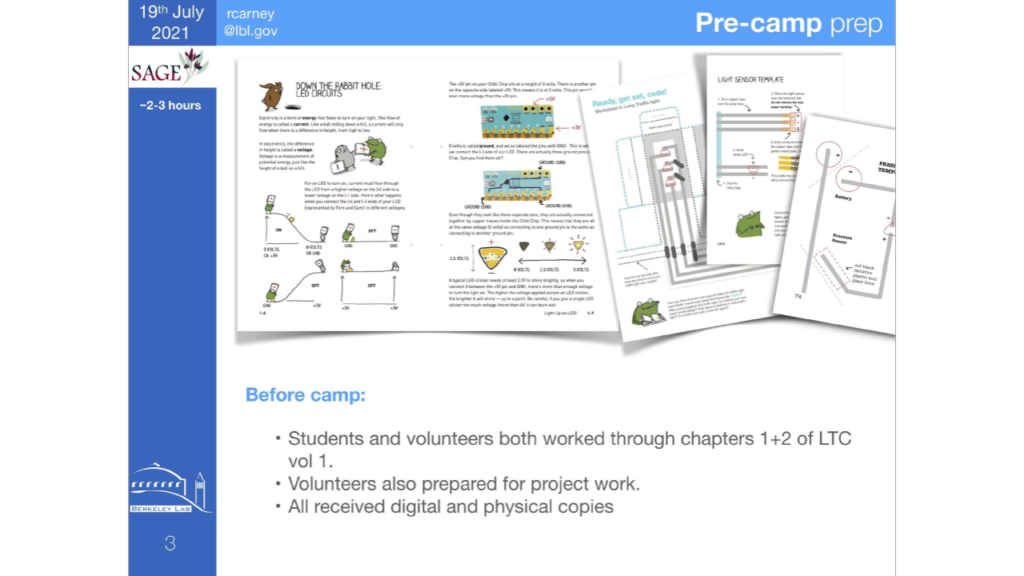
ALEKSANDRA: Organizing online events is challenging. We already had some experience with the organization of Nuclear Science day and ATLAS Masterclass for high school students. We wanted to have small groups of students in rooms so the volunteers could engage with everyone. So we needed a lot of volunteers. On the other hand we also had 4 tracks (introductory/advanced + programming-focused/electronics-focused), which students could choose based on their pre-work and interests.
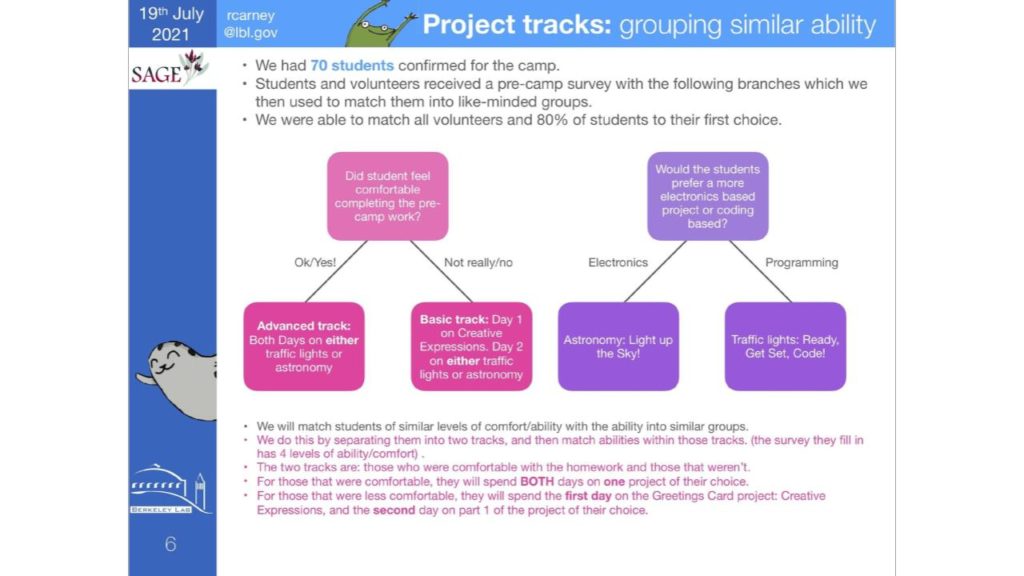
That also meant that we had to train volunteers for all these different options in advance. Thinking how there is always something which can go wrong, we had helpers who were always ready to jump into a room and help the student or the volunteer who needed help.
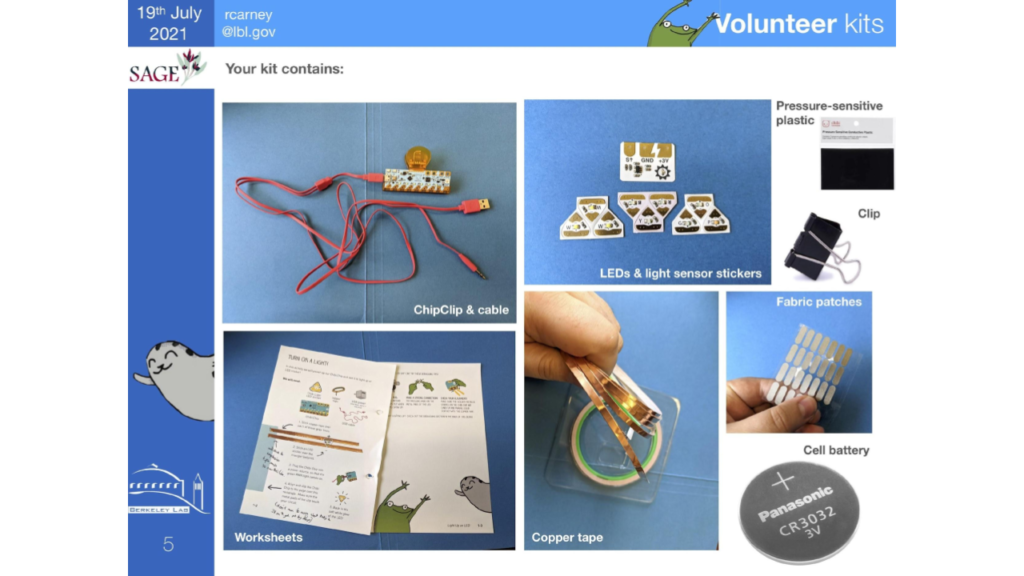
Dedicated Discord channels helped manage all that. In the end we tried to anticipate everything that could go wrong and have a ready solution. In the end, it was very rewarding seeing a smile on the students faces when the first LED was on!
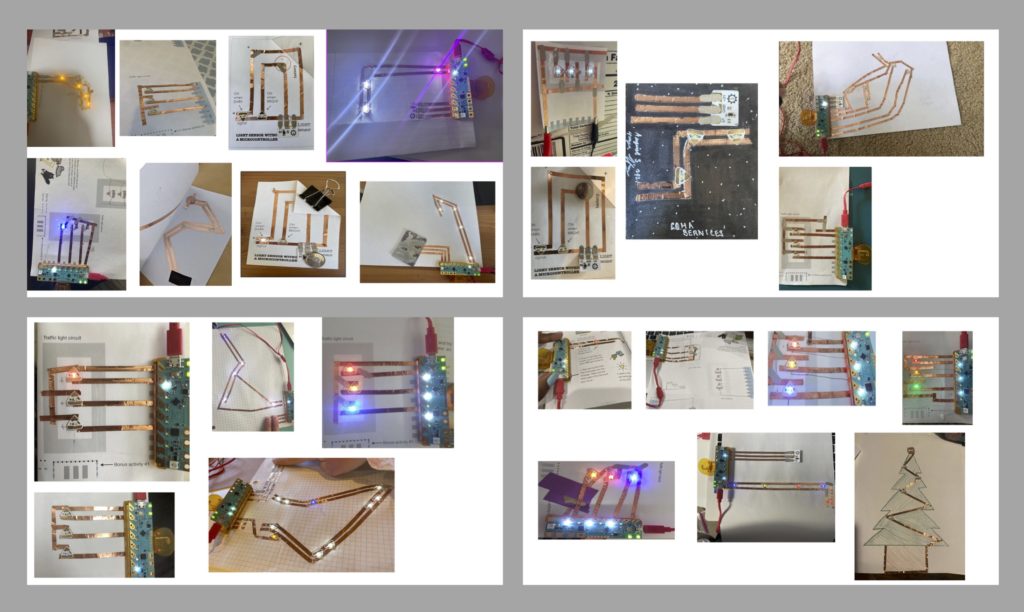
REBECCA: Before camp started we had a check-in session where we asked all the students to plug in and program their Chibi Chips over Zoom – that gave us so much insight into how the camp would go, e.g. if students were zoom-ing over the device they were also programming with they wouldn’t be able to hear since programming is done using an audio-jack. It also helped us identify early who was having more fundamental difficulties, e.g. with powering or with an audio driver.
On the Sunday before camp with the check-in session and the pre-camp work under their belt students were asked to rank the work in terms of whether they’d been able to finish it and how hard they’d found it. We used this to determine whether they’d be placed on an introductory or advanced track during camp. They were also asked to choose between an electronics-based challenge and a programming-based challenge. We felt that giving them some agency in how they would spend their time would help increase engagement with the program.
< The K12 Educator Perspective >
CHIBI: Alisa, you’re unique on the team in that you have classroom experience. How did this project unfold for you – in terms of pacing and delivery and engagement and troubleshooting — and what advice can you share for others doing similar hands-on work with science, equity and outreach, and related diversity work with professionals which involves career shadowing and hands-on learning?
ALISA: I believe when designing STEM outreach experiences, it’s important that students are provided with authentic experiences that reflect the skills STEM professionals use in their work. It was incredible to work with Rebecca and Aleksandra who are physicists at Berkeley Lab and really understood the underlying science of the Chibi Chip and other Chibitronics components. They really transformed my view of Chibitronics as not just an educational tool, but really as a scientific tool that would allow for students to have authentic learning experiences in electronics and coding.
To support the subject expertise in physics, electronics, and coding provided by Rebecca and Aleksandra, I utilized my experience as a former high school science teacher in providing the scaffolding – ensuring that our content was accessible and engaging to our students. This included breaking up the content in chunks, providing questions to check for understanding, and lots of visual aids especially considering that all of this would be virtual.
Another thing that we especially considered for the virtual environment was troubleshooting, which is a bit more challenging compared to an in-person environment where you can have someone look at your physical circuits directly. We provided resources and hints for students in case their code or circuits weren’t working as expected and utilized Discord so students could ask questions directly to project facilitators.
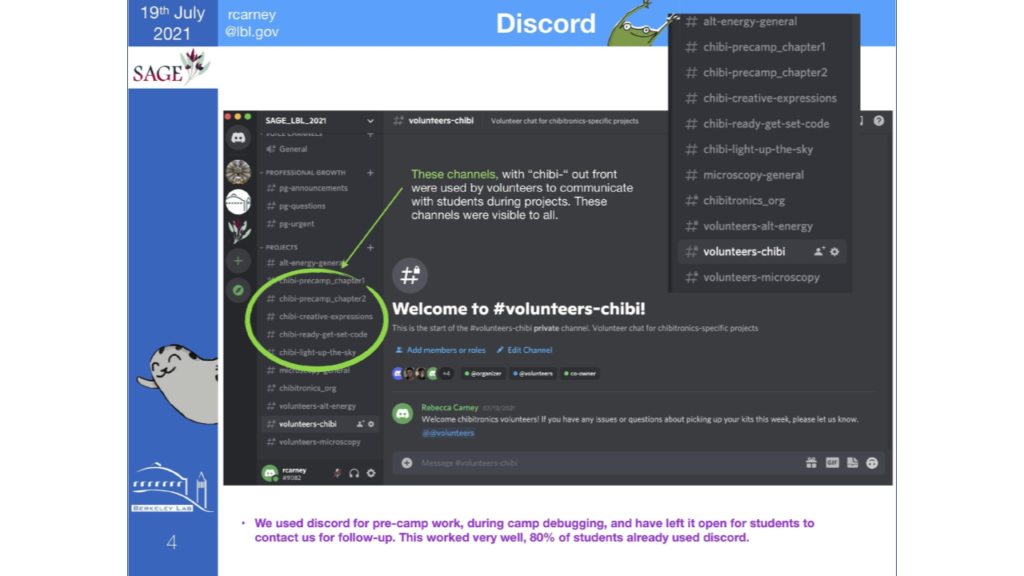
Finally, we spent lots of time discussing and planning how to provide multiple project choices to engage with all students, regardless of their background. With around 70 students from different schools across grades 9 through 11, students came in with varying background knowledge and experiences. This is how we ended up with our three different project paths (with multiple activities within!), to not only provide multiple ways to engage with the material, but to give students agency in choosing what project(s) matched closest with their interests. Logistics-wise we had to incorporate extra steps such as finding enough scientist volunteers and organizing break-out rooms groups, but it was necessary to ensure that we reached all students.
CHIBI: Elina, you coordinate the LBNL SAGE Camp participants, the young women who took part in the program this summer. What was it like organizing such a hands-on program for virtual delivery? Were there certain choices you made to help build a sense of community and connection? What can you share about the experience from your perspective in terms of how the young women engaged in the program this summer?
ELINA: This was the second time we did a virtual SAGE camp, so it was a lot smoother than LBNL SAGE Camp 2020 (also virtual). It is very tricky to create a sense of community online, so we decided to use Google Classroom (a platform most students are familiar with) to communicate with them and also Discord, where students could connect with each other and the Project volunteers to ask for help and show off their individual projects.
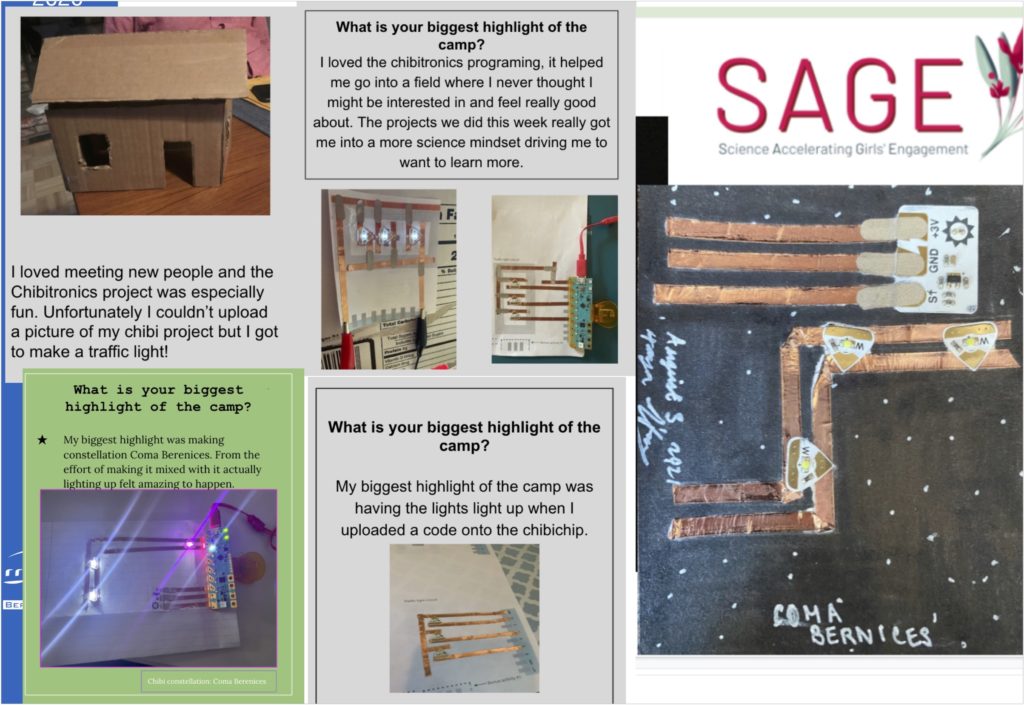
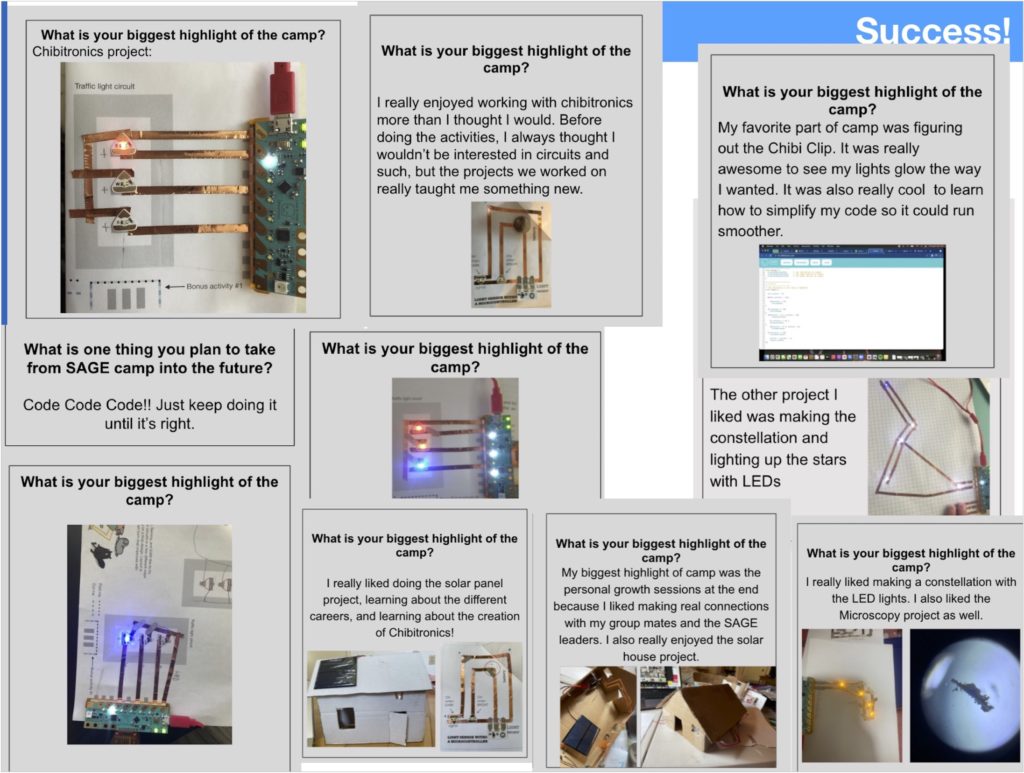
It was great seeing students interact with Rebecca and Aleksandra as well as other project leaders. Although it doesn’t replace face to face engagement, I feel the Discord channels did a great job of making people more accessible, and avoiding Zoom fatigue! By creating that accessibility, it helped the students feel like they belonged and in turn helped fulfill our ultimate camp goal; to convince young women that STEM and careers at DOE National Labs are for them!
< Jie’s Journey >
CHIBI: Jie, you’ve done lots of talks on your work, the inspiration for circuit stickers, and your company Chibitronics, the formation of which was integral to your research at MIT. Your work with art and engineering has helped make paper circuits into a recognized kind of craft around the world. What was it like for you to share some of your experience with a group of 70 young women?
JIE: I really enjoyed getting to meet (briefly!) the young women who participated! I am often removed from the creative and learning experiences of people actually making paper circuits so it’s always fun to connect on a more personal level. I got to share about my own journey as a person and I hope that it was interesting for them to see this side.
I discovered that the participants each received journals as part of the program and that made me smile because it’s something I do for self-care too! Also, after the conversation one of the participants reached out to me on Linkedin and we connected there. It’s really rewarding and exciting to see this group of really motivated and fearless young ladies. I’m cheering them all on 🙂
< Sharing Authentic STEM Experiences >
CHIBI: Faith, the 2021 program (during the pandemic!) was such a good demonstration of so many things. Can you share some thoughts on LBNL’s version of the job shadow, the workplace learning experience? These kinds of experiences are so valuable for young people, young women in particular. We’d be thrilled if other research organizations and community programs were to follow your lead in the approach and execution.
FAITH: Our greatest strength as a national lab are our researchers and the people that support the mission science that takes place here. From leadership on down, we’ve received amazing support for each program, especially SAGE, through funding, time commitments, and outreach. Staff took the time to take pictures and video of their workspace to develop virtual tours for their job shadow experiences. Our projects team really worked hard to make sure that each project connected to specific aspects of the work they do here at the Lab. Finally, our professional development team thought about what they wished they would have known on their journey to becoming a STEM professional. Those efforts really helped to create the authentic experience we believe we can build, especially as we move to hybrid and in-person programming.
CHIBI: Many thanks to you, the team, and your LBNL SAGE Camp students for your work last summer and for contributing to this piece. What’s the best way for people to reach you and the K12 group at LBNL?
FAITH: Thank you for asking us to contribute! It’s been wonderful to reflect on this process and document the development of the program last year. The best way to find out about our work is to visit K12education.lbl.gov. We are also on twitter @lbnlnext and instagram @lbnl_next.
The SAGE program is supported at multiple DOE national labs. You can find more information about the SAGE consortium at https://mysagejourney.org.
Acknowledgements
The Berkeley Lab K-12 STEM Education and Outreach Programs would like to thank all our scientist volunteers for making SAGE and other K-12 programs a success. In particular, we would like to thank Rebecca Carney and Aleksandra Dimitrievska for their dedication to the Chibitronics project for SAGE. We would also like to thank other members of the SAGE 2021 Short Projects Committee: Natasha Brown (Co-lead), Rebecca Sugrue (Co-lead), Nuria Casquero-Modrego, Sarah Dischinger, Samanvitha Murthy, Jennifer Wacker, Aizah Khurram and Mon Oo Yee.
Image Credits
Thanks to the LBNL SAGE Lab team for the use of selected slides in their post-workshop PowerPoint deck. Program description detail, including student comments and project photography, was organized by the LBNL K12 team as part of their documentation and review process.

